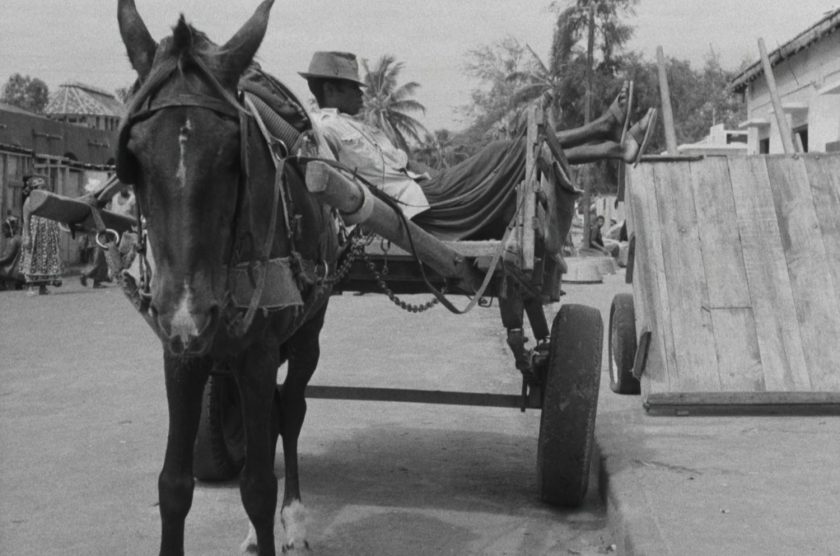Borom Sarret
by Ousmane Sembène
Senegal, 1963
program:
El cine después de la liberación
about the film
Borom Sarret Sarret is a twenty-minute short film released in 1963, considered by critics to be the first film made by a black African* director. Faithful to his reputation as a committed filmmaker and writer, Sembène does not deviate from this path in Borom Sarret. Borom Sarret, as the name suggests, follows the daily trials and tribulations of Abdoulaye Ly, a cart driver by trade. He travels around certain roads of Dakar, his cart pulled by his loyal horse AlBourakh.
In a post-independence Dakar society, as it was in 1963, three years after gaining independence, it is interesting to see at which point classism and racism intersect in a metropolis where the former colonizers and the native population – called “indigenous” – live together. Using his cart as a means of transportation, Abdoulaye leaves the indigenous district every morning, hoping that he will make enough money to sustain his family, through the customers who get into his cart.
In a Dakar that was seemingly modern and on the way towards socio-economic development, it was fashionable to think that independence would resolve all the problems of the metropolis’ inhabitants. But the dichotomy of class persists between the Plateau, Dakar’s central business district, and between the homes of several white families and the indigenous neighborhoods. Abdoulaye bears the consequences of this dynamic, taking care never to cross the invisible but tangible boundaries regulating social life in Dakar.
In Borom Sarret, Sembène created a precise painting of the everyday lives of the working class, who, from within their proletarian living conditions, hope every day for a better tomorrow. The central character of the cart driver, embodied by Abdoulaye, represents the peak of the proletarian condition at the time. It is important to note that due to a lack of transportation infrastructure, this same cart still serves as a means of transportation in certain areas of Senegal today.
*“Black African” here refers to a continental African person. This is the preferred wording of the author and is translated directly from the original French text.
historic context
The direct European occupation of Western Africa began in the 15th century and ended when Senegal and its neighbors gained their formal independence at the turn of the 1960s. The region experienced almost 500 years of domination and exploitation by competing European powers, such as Portugal, Great Britain, and the Netherlands. France established its first colonial trading base at the mouth of Senegal in 1638 and chose Dakar as the capital of its West African colonial empire in 1870.
While formal independence did not lead to the full benefits of freedom that the people of Senegal had hoped for, it did make space for an outburst of emancipatory cultural and artistic expression.
sobre el director
Ousmane Sembène is a writer and film director from Senegal. He is regarded as one of the pioneers of African cinema, more specifically the genre of film referred to as “African cinematic realism”. He saw filmmaking as an extension of his political activism and used the medium to make his critique of hegemonic forces, such as colonialism, patriarchy, and capitalism, easily accessible to a broad African audience outside of elite circles. Due to the socio-political nature of his work, Sembène’s films had previously been banned in both Senegal and France.
His artistic journey reached its peak in the early 1960s when Senegal gained its independence from direct French colonial rule. In a time when cultural representation and artistic expression found new space to flourish, his practice offered a strong reflection of Senegal’s struggle for complete emancipation.
about the author of this text
Ndèye Fatou Kane is a Senegalese blogger, writer and researcher. After being one of the first people in Senegal to have created a literary blog, she began writing. Her first novel Le Malheur de Vivre (The Misfortune of Living) was published in 2014. She then switched to feminist activism and gender studies. Her research first focused on Senegalese feminism and intersectionality, then on the construction of Senegalese masculinities from a politico-religious perspective.
